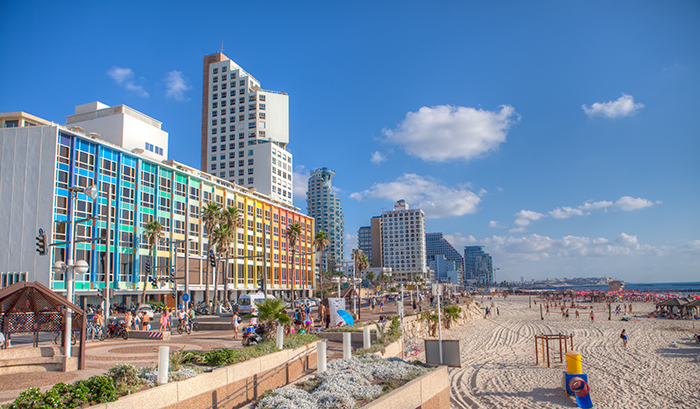Dateline Jerusalem — Lately I have had the opportunity to visit Tel Aviv on several occasions. A must-see for tourists. Along the shores of the Mediterranean Sea, it has pristine white beaches. Turquoise and aquamarine clear blue waters make it a popular vacation spot. Known as The City That Never Sleeps, Tel Aviv often is compared to Las Vegas. Both have 24-hour entertainment, clubs, bars, restaurants, all-night partying. Tel Aviv also is a city of museums, an opera house, live theater, the world-renowned Israel Philharmonic Orchestra, and various cultural activities.
Dense Population
The metropolitan area is the largest population center in Israel. Almost half of Israel’s people live in Tel Aviv and surrounding cities. But the population of the city itself is only the second largest city in Israel after Jerusalem.
I live 12 miles away, if I were a bird flying in a straight line. By train it takes me 30 minutes, by car 25 minutes without traffic. As with most major cities, rush hour is a nightmare. The parking lot freeways of Los Angeles are a piece of cake in comparison.
Tel Aviv’s White City is a World Heritage site, famous for its Bauhaus- style architecture of the 1920s. Bauhaus is characterized by white walls, rounded corners, balconies, flat roofs, building pillars, and thermometer windows. Near the White City is the Allenby Market, an open air shuk (bazaar) with little stalls of all kinds of merchandise cramped close together and separated by narrow aisles. Besides shawls, scarves tablecloths, clothing, jewelry and Judaica items, vendors sell fresh fish, fruits and vegetables, spices and nuts. One stand had pomegranates the size of large grapefruits. Another had vegetables I never have seen before. The better known Carmel Shuk is adjacent to the Allenby Market.
Then there is Sarona, a newly renovated area in the center of the city, surrounded by high-rise buildings. In 2014 the complex reopened, having had restored 33 German Templar buildings built in the late 1800s. These old buildings have become exclusive boutiques, designer shops, art galleries, wonderful cafes, restaurants and bars. The buildings are scattered amid greenery, gardens and flowers. The indoor Sarona Market offers restaurants, bakeries, stalls and stands of spices, fruits, vegetables, meats, fish, wines, cheese, and a myriad of sweets and desserts. It is like the Los Angeles Farmers Markets on steroids!
Building Beauty
One group of old buildings in the center of the city appears to have heavy wooden doors and thick shutters covering their windows, similar to the architecture of homes in New Orleans. However, the doors and shuttered windows are fake. They are realistically painted on large boards attached to the windowless exteriors of the buildings. Viewing them from across a wide boulevard, they resemble regular buildings with windows and doors. Up close, the buildings have no windows, just expertly painted boards made to look like the real thing.
Of course, Tel Aviv is known for its magnificent skyline that rivals New York City. The high-rise buildings are not only beautiful, but unique. For example, there is a building purposely built to look like it is leaning to one side and ready to tip over, an Israeli version of the Leaning Tower of Pisa. One newer building under construction reminds me of an upside down pyramid. It is all an illusion. A few buildings seem to have giant concrete champagne glass-shaped structures sitting atop their roofs, some eerily looking like flying saucers, but these are actually helicopter pads located on top of the skyscrapers. Each building is one of a kind. The only commonality is being constructed of steel and green or blue tinted walls of glass.
Azrieli Towers is one of the most famous high rise structures, an unusual trio of buildings connected by a four-story shopping mall at their bases. The buildings are between 42 and 49 stories. Each tower has a different geometric shape. One building is circular, one triangular, one square. The circular tower is the tallest, and it is the second tallest building in Israel. The mall connecting the towers is one of the largest indoor malls in Israel. It is attached to a pedestrian bridge linking it to the Railway Station.
The name Tel Aviv literally means Spring Mound or Hill. A Tel is an archaeological site that reveals layers of civilization built over the other. It is essentially a mound or hill built on ruins of ancient settlements inhabited by people for thousands of years or a hill in an archeological excavation. “Aviv” means spring. The city of Tel Aviv was named because it represented the rebirth of the Jewish nation in a place where it was previously.
L’hitraot. Shachar

